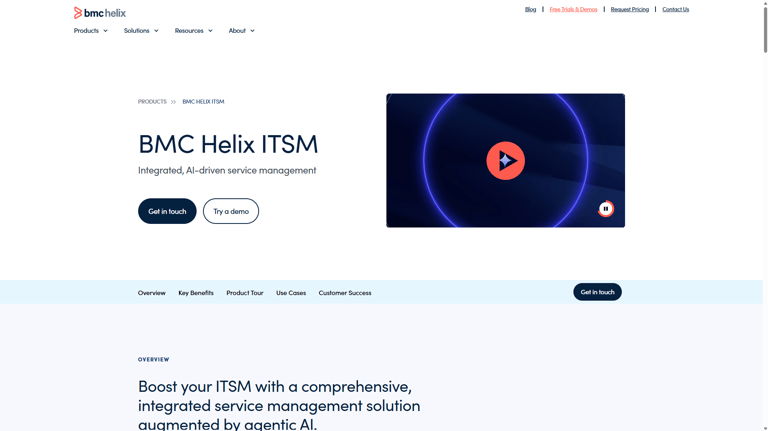When it comes to IT Service Management (ITSM), BMC Footprints and BMC Helix ITSM (formerly Remedy) are two well-known tools on the market. However, choosing the right ITSM solution requires careful consideration, as each tool offers different features and benefits. In this blog post, we’ll compare BMC Footprints vs Remedy, exploring their key differences.
Additionally, we’ll introduce InvGate Service Management, our own ITSM solution that stands out as a modern, feature-rich alternative to both. Selecting the right ITSM tool can make all the difference for your service desk operations, and with alternatives like InvGate Service Management available, it's essential to weigh your options carefully.
Let’s dive into the details to help you make the best choice for your organization.
Methodology
Before we begin, it’s worth noting that InvGate develops IT Service Management and IT Asset Management software, so we actively participate in this market.
Some of the products mentioned here are offered by competitors. Still, our goal is to provide clear, factual, and helpful insights to guide your decision-making process.
Our analysis relies on information from multiple public sources, including vendor websites, product documentation, user feedback on Gartner Peer Insights, G2, and Capterra, as well as analyst reports and product demos when available. Each tool is evaluated across key aspects such as functionality, available pricing details, integrations, usability, and customer support.
All data is current as of November 2025. We review and update our articles regularly to reflect product and market changes.
BMC Software offers several products that address IT Service Management at different levels of scale and complexity. Their portfolio evolved over time to serve both mid-market companies looking for a straightforward service desk and large enterprises managing global service operations. Instead of maintaining a single, one-size-fits-all platform, BMC provides a range of tools that can be deployed independently or together, depending on the organization’s maturity and needs.
Beyond IT Service Management, BMC’s ecosystem includes solutions for IT operations, discovery, automation, and digital service optimization.
Within the ITSM space specifically, Helix ITSM is BMC’s main solution. FootPrints, a legacy platform, focuses on core processes and usability for mid-sized environments, while Helix ITSM extends those capabilities into a full-scale enterprise platform built for automation, AI, and multi-cloud integration.
Helix is a cloud-first product suite, whereas FootPrints is only for self-managed environments (Hosted FootPrints has reached EOL).
BMC FootPrints overview
FootPrints is a service-management platform from BMC Software originally targeted toward mid-sized organisations (though usable in larger ones) with a classic service desk plus asset/CMDB capabilities. It provides core ITSM features such as incident management, Problem Management, asset tracking, and self-service portals.
BMC FootPrints is a legacy ITSM platform. That means it’s still supported and available, but it’s no longer a focus for new development. BMC keeps providing updates and technical assistance for customers with active support contracts, yet new features or major improvements are unlikely.
BMC FootPrints features
Here’s what BMC FootPrints typically covers, according to their official web (accesed November 2025):
- Incident/request management: With ticketing history and templates. Customized reports and dashboards.
- Change Management: Change planner, change history for audits.
- Asset and configuration item (CI) tracking: Especially strong in linking assets to requests and issues.
- Service catalog and portfolio: Define and publish services, link contracts to services.
- Workflow automation, with rules and approvals.
BMC Footprints pricing
BMC Footprints pricing is not publicly listed.
BMC Footprints reviews and rating
Gartner peer insights score: 3.6
G2 score: 3.5
BMC Helix ITSM overview
 Formerly known as BMC Remedy, BMC Helix ITSM is a more advanced, enterprise-grade ITSM solution from BMC. It builds on the legacy of Remedy and other BMC platforms, but is cloud-ready, offers broader scale, and aligns with modern demands such as multi-cloud, automation/AI, integration, and broad Service Management.
Formerly known as BMC Remedy, BMC Helix ITSM is a more advanced, enterprise-grade ITSM solution from BMC. It builds on the legacy of Remedy and other BMC platforms, but is cloud-ready, offers broader scale, and aligns with modern demands such as multi-cloud, automation/AI, integration, and broad Service Management.
Built with AI-driven automation and cloud-native architecture, Helix ITSM stands out for its scalability and ability to handle a high volume of service requests. It’s also highly customizable.
BMC Helix ITSM features
Here are some of the features that Helix covers, according to their official web (accessed November 2025):
-
Full ITIL process coverage: incident, problem, change & release, service configuration/CMDB, Asset Management, service-request fulfilment.
-
Advanced automation and AI capabilities: predictive issue resolution, cognitive agent assistance, workflow automation at scale.
-
Deployment flexibility: cloud-native, hybrid, ability to run containerised environments in public/private clouds.
-
Enterprise reporting and analytics: Dashboards that show KPIs, deviation from targets, and broad visibility across service operations.
BMC Helix ITSM pricing
BMC Helix ITSM pricing is not public; you must contact BMC directly for a quote tailored to your needs. Pricing depends on various factors, including the number of users and modules, deployment choice, and support services.
BMC Helix ITSM rating and reviews
When comparing BMC Footprints and BMC Helix ITSM (formerly Remedy), it’s important to highlight the differences that set them apart. While both tools are powerful, they cater to different organizational needs. Let’s look at eight key differences between the two:
- Deployment options: BMC Footprints is an on-premise solution, giving organizations full control over their infrastructure. BMC Helix ITSM, on the other hand, is primarily a cloud-based platform, offering greater flexibility for businesses that prefer to avoid managing hardware.
- Customization: Both solutions offer customization, but Helix ITSM allows for more extensive changes due to its cloud-native architecture. Footprints is more limited in this regard, though it still offers flexibility in workflow creation and configuration.
- Scalability: BMC Helix ITSM is designed to scale with large enterprises, handling a high volume of service requests and incidents. Footprints, while scalable, is better suited for midsize organizations that may not need the full power of Helix ITSM.
- AI and automation: Helix ITSM stands out for its use of AI-driven automation, particularly in areas like incident management and predictive analytics. Footprints does not have the same level of AI capabilities, making Helix ITSM a more advanced solution for businesses looking to automate routine IT tasks.
- IT Asset Management: While both tools offer IT Asset Management features, Footprints places a stronger emphasis on this capability. It integrates deeply with the service desk to ensure assets are managed throughout their lifecycle. Helix ITSM includes Asset Management but focuses more on Service Management automation.
 If neither BMC Footprints nor Helix ITSM seems like the right fit for your organization, InvGate Service Management could be the solution you’re looking for. Designed to offer a blend of powerful features and ease of use, InvGate Service Management provides a modern ITSM experience without the complexity and high cost of some other solutions.
If neither BMC Footprints nor Helix ITSM seems like the right fit for your organization, InvGate Service Management could be the solution you’re looking for. Designed to offer a blend of powerful features and ease of use, InvGate Service Management provides a modern ITSM experience without the complexity and high cost of some other solutions.
InvGate Service Management strikes a balance between functionality, usability, and affordability.
InvGate Service Management features
-
Ticket management: Automates ticket assignment, categorization, and prioritization with SLA tracking to improve response and resolution times.
-
Self-service portal: Lets users submit requests, access the knowledge base, and track progress, reducing workload on IT teams.
-
IT Asset Management: Integrates asset tracking through InvGate Asset Management to give full visibility into hardware and software lifecycles.
-
Automation and workflows: Streamlines repetitive tasks like approvals and escalations, improving efficiency and accuracy.
-
Reporting and analytics: Delivers insights into ticket trends, SLA compliance, and team performance for data-driven decisions.
-
No-code workflow builder: Lets teams design and modify workflows, even without technical expertise, adapting processes quickly as needs change.
-
AI-powered assistance: Includes features like AI-Improved Responses, Ticket Summarization, Knowledge Article Generation, solution recommendations, and a contextual virtual agent that suggests relevant content or flags tickets at risk of SLA breaches.
InvGate Service Management pricing
InvGate offers flexible pricing plans:
- Starter at $17/agent/month up to 5 agents.
- Pro at $40/agent/month from 6-50 agents.
- Enterprise offers custom pricing for larger organizations.
You can also sign up for a 30-day free trial, no credit card required.
InvGate Service Management user reviews and ratings
Disclaimer: All product names, logos, and brands are property of their respective owners. All company, product, and service names used on this site are for identification purposes only. Use of these names, trademarks, and brands does not imply endorsement. Comparisons are based on publicly available information as of November, 2025 and are provided for informational purposes only.













 Formerly known as BMC Remedy, BMC Helix ITSM is a more advanced, enterprise-grade ITSM solution from BMC. It builds on the legacy of Remedy and other BMC platforms, but is cloud-ready, offers broader scale, and aligns with modern demands such as multi-cloud, automation/AI, integration, and broad Service Management.
Formerly known as BMC Remedy, BMC Helix ITSM is a more advanced, enterprise-grade ITSM solution from BMC. It builds on the legacy of Remedy and other BMC platforms, but is cloud-ready, offers broader scale, and aligns with modern demands such as multi-cloud, automation/AI, integration, and broad Service Management. 
 If neither BMC Footprints nor Helix ITSM seems like the right fit for your organization,
If neither BMC Footprints nor Helix ITSM seems like the right fit for your organization, 

